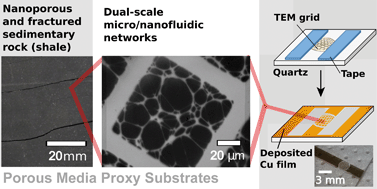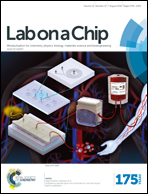Subsurface to substrate: dual-scale micro/nanofluidic networks for investigating transport anomalies in tight porous media†
Abstract
Micro/nanofluidic experiments in synthetic representations of tight porous media, often referred to as “reservoir-on-a-chip” devices, are an emerging approach to researching anomalous fluid transport trends in energy-bearing and fluid-sequestering geologic porous media. We detail, for the first time, the construction of dual-scale micro/nanofluidic devices that are relatively large-scale, two-dimensional network representations of granular and fractured nanoporous media. The fabrication scheme used in the development of the networks on quartz substrates (master patterns) is facile and replicable: transmission electron microscopy (TEM) grids with lacey carbon support film were used as shadow masks in thermal evaporation/deposition and reactive ion etch (RIE) was used for hardmask pattern transfer. The reported nanoscale network geometries are heterogeneous and composed of hydraulically resistive paths (throats) meeting at junctures (pores) to mimic the low topological connectivity of nanoporous sedimentary rocks such as shale. The geometry also includes homogenous microscale grid patterns that border the nanoscale networks and represent microfracture pathways. Master patterns were successfully replicated with a sequence of polydimethylsiloxane (PDMS) and Norland Optical Adhesive (NOA) 63 polymers. The functionality of the fabricated quartz and polymer nanofluidic devices was validated with aqueous imbibition experiments and differential interference contrast microscopy. These dual-scale fluidic devices are promising predictive tools for hypothesis testing and calibration against bulk fluid measurements in tight geologic, biologic, and synthetic porous material of similar dual-scale pore structure. Applications to shale/mudrock transport studies in particular are focused on herein.


 Please wait while we load your content...
Please wait while we load your content...